September 8 – 22, 2015 –
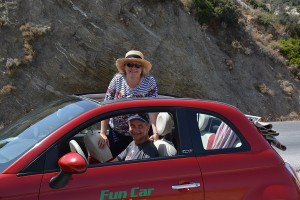 With Sara gone for a week plus, Bob, John and Eileen rented a car and explored the island for two days. Naxos is the largest island in the Cyclades, mountainous throughout, and has the tallest peak of all the islands. The Cyclades is the island group in the Eastern Aegean and consists of the Northern, Central and Southern Cyclades.
With Sara gone for a week plus, Bob, John and Eileen rented a car and explored the island for two days. Naxos is the largest island in the Cyclades, mountainous throughout, and has the tallest peak of all the islands. The Cyclades is the island group in the Eastern Aegean and consists of the Northern, Central and Southern Cyclades. 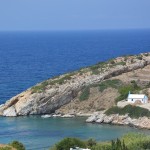 The center of the island is filled with lush, fertile valleys, growing figs, citrus, olives, grapes, corn and potatoes.
The center of the island is filled with lush, fertile valleys, growing figs, citrus, olives, grapes, corn and potatoes. 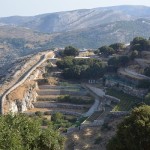 The grapes are used for wine production which the island is very proud of.
The grapes are used for wine production which the island is very proud of.
In the southern end of the island there is a prominent marble quarry that is taking down one of the mountain peaks, block by block. It is interesting to see how much marble is used for mundane projects, such as sidewalks, stone walls and jetties just because it is available. If only the marble natural resource were not so expensive to transport the island would be rich beyond their dreams. It seems odd to see so much beautiful marble scattered about like it was worthless rock. 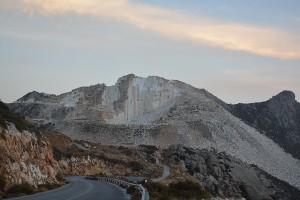 The marble from Naxos is prized for its white translucent appearance. Although many ancient temples in Greece are constructed of marble, the marble we saw at Dimitra’s Temple here in Naxos was especially beautiful. For this temple, the rafters and even the roof was marble.
The marble from Naxos is prized for its white translucent appearance. Although many ancient temples in Greece are constructed of marble, the marble we saw at Dimitra’s Temple here in Naxos was especially beautiful. For this temple, the rafters and even the roof was marble. 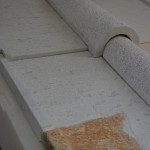 It was explained that the marble roof allowed sunlight to enter the temple and wash the interior with a soft glow. No doubt, adding to the spiritual effect of going to temple.
It was explained that the marble roof allowed sunlight to enter the temple and wash the interior with a soft glow. No doubt, adding to the spiritual effect of going to temple.
A short distance out of Naxos Town, we visited an olive museum and store. The museum was an actual olive pressing operation and the exhibits showed the process by which the olives are pressed into olive oil. The equipment is the same everywhere. It starts with the olives getting crushed under the weight of a huge stone roller rolled around a center pivot by several men. 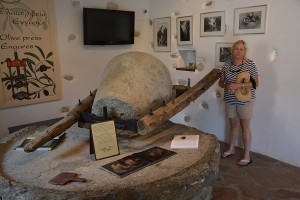 Next, the olive mash, including the crushed pits which contain most of the oil are transferred to a mechanical press much like a cider press. This spot was once the press for an individual family but would take in olives from others for a portion of the olive oil as payment. Today, most families grow enough olives for their own consumption of olives and olive oil. Since the volume is relatively small, families or entire communities often share a single olive pressing operation. There is also a cooperative press on the island for commercial production.
Next, the olive mash, including the crushed pits which contain most of the oil are transferred to a mechanical press much like a cider press. This spot was once the press for an individual family but would take in olives from others for a portion of the olive oil as payment. Today, most families grow enough olives for their own consumption of olives and olive oil. Since the volume is relatively small, families or entire communities often share a single olive pressing operation. There is also a cooperative press on the island for commercial production.
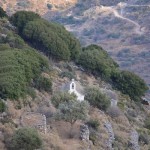 On the north end of the island is the town of Apollonas named for the god Apollo. Getting to the town was an experience in navigating steep roads and switchbacks, of course with minimal or no guardrails.
On the north end of the island is the town of Apollonas named for the god Apollo. Getting to the town was an experience in navigating steep roads and switchbacks, of course with minimal or no guardrails. 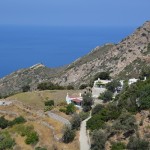 Along the way the lush landscapes of high mountains and Mediterranean vistas dotted with scores of white washed churches was stunning.
Along the way the lush landscapes of high mountains and Mediterranean vistas dotted with scores of white washed churches was stunning.
Once there you felt like staying for a week. The town surrounds a pristine cove and beach for swimming. On the edge of the beach are restaurants and tavernas where you could spend the entire day sipping Greek wine while dangling your feet in the sand. 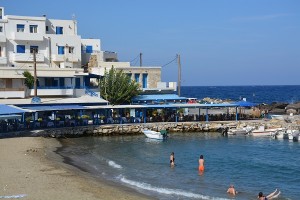 The Greeks have a laid back way of life that is rather appealing.
The Greeks have a laid back way of life that is rather appealing. 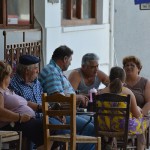 We often see locals socializing in outdoor tavernas and on sidewalk benches right in town.
We often see locals socializing in outdoor tavernas and on sidewalk benches right in town.
Unfortunately the day drew to an end and we had to get John and Eileen back to catch the ferry to Santorini to continue their vacation. Bob returned for some optional boat work and to anxiously await the arrival of our niece Lauren and her boyfriend Mark.
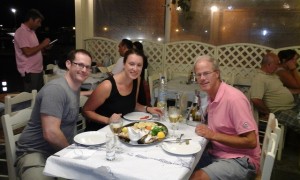 On Friday, Lauren and Mark arrived from Maine ready to go after 26 straight hours of travel. We love their enthusiasm for all things travel! Undeterred, their first Greek meal was a total delight at one of the tavernas, Nteouvtas, near the boat where Bob had become friendly with the head waiter. Bob’s new friend George took great care of us and even convinced Lauren to try their tasty Octopus which is uniquely prepared by hanging the octopus on lines to dry in front of the restaurant the day before.
On Friday, Lauren and Mark arrived from Maine ready to go after 26 straight hours of travel. We love their enthusiasm for all things travel! Undeterred, their first Greek meal was a total delight at one of the tavernas, Nteouvtas, near the boat where Bob had become friendly with the head waiter. Bob’s new friend George took great care of us and even convinced Lauren to try their tasty Octopus which is uniquely prepared by hanging the octopus on lines to dry in front of the restaurant the day before.
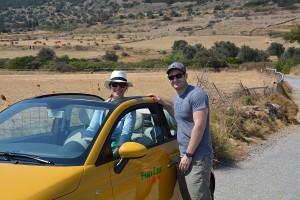 The next day the threesome hopped back in the car and re-explored the entire island. Joined the following day by Sara, who had just arrived the night before from her 26 hours of travel, we headed back to Apollonas for another relaxing day at the tavernas along the beach.
The next day the threesome hopped back in the car and re-explored the entire island. Joined the following day by Sara, who had just arrived the night before from her 26 hours of travel, we headed back to Apollonas for another relaxing day at the tavernas along the beach.
It was time to move on to explore more of the Greek islands. The meltimi that had been blowing for most of ten days was supposed to be calming so we headed south toward Iriklia as a stopover spot before the island of Ios. Unfortunately, the winds had not calmed as much as we would have liked and the seas were still steep. It made an uncomfortable ride. Arriving in Iriklia we were fortunate to get the last berth on a small quay at the end of a long cove on the northern end of the island. A quick med-moor and we were settled in, protected from the still rough seas.
Iriklia is a small island with few inhabitants and a tiny village. We spent two nights and one full day there, swimming and walking the town. We were able to see most of the town in about 20 minutes. As an island nation, Greece has an amazing ferry service that is not expensive and very reliable. 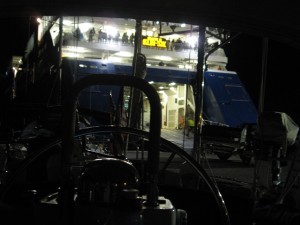 Even little Iriklia had good ferry service. Most of the ferries that came in were small. At 2 am one night, however, one of the largest ferries in the islands arrived with its lights blazing. The back of the ferry opened to the small quay and several cars got on and several got off, and it was gone. It reminds me of Southwest Airlines, with the speed in which it does its turnarounds. It was so quick that three of the four crew members aboard slept through it. The fourth took photos to prove it was there!
Even little Iriklia had good ferry service. Most of the ferries that came in were small. At 2 am one night, however, one of the largest ferries in the islands arrived with its lights blazing. The back of the ferry opened to the small quay and several cars got on and several got off, and it was gone. It reminds me of Southwest Airlines, with the speed in which it does its turnarounds. It was so quick that three of the four crew members aboard slept through it. The fourth took photos to prove it was there!
The seas have calmed and we are on to Ios.
